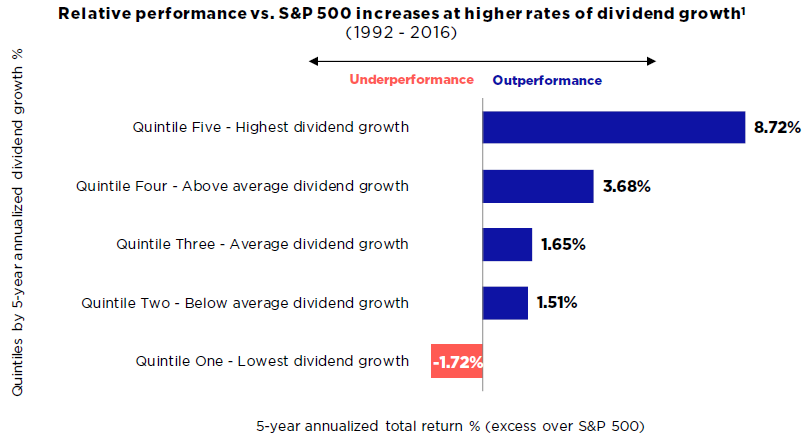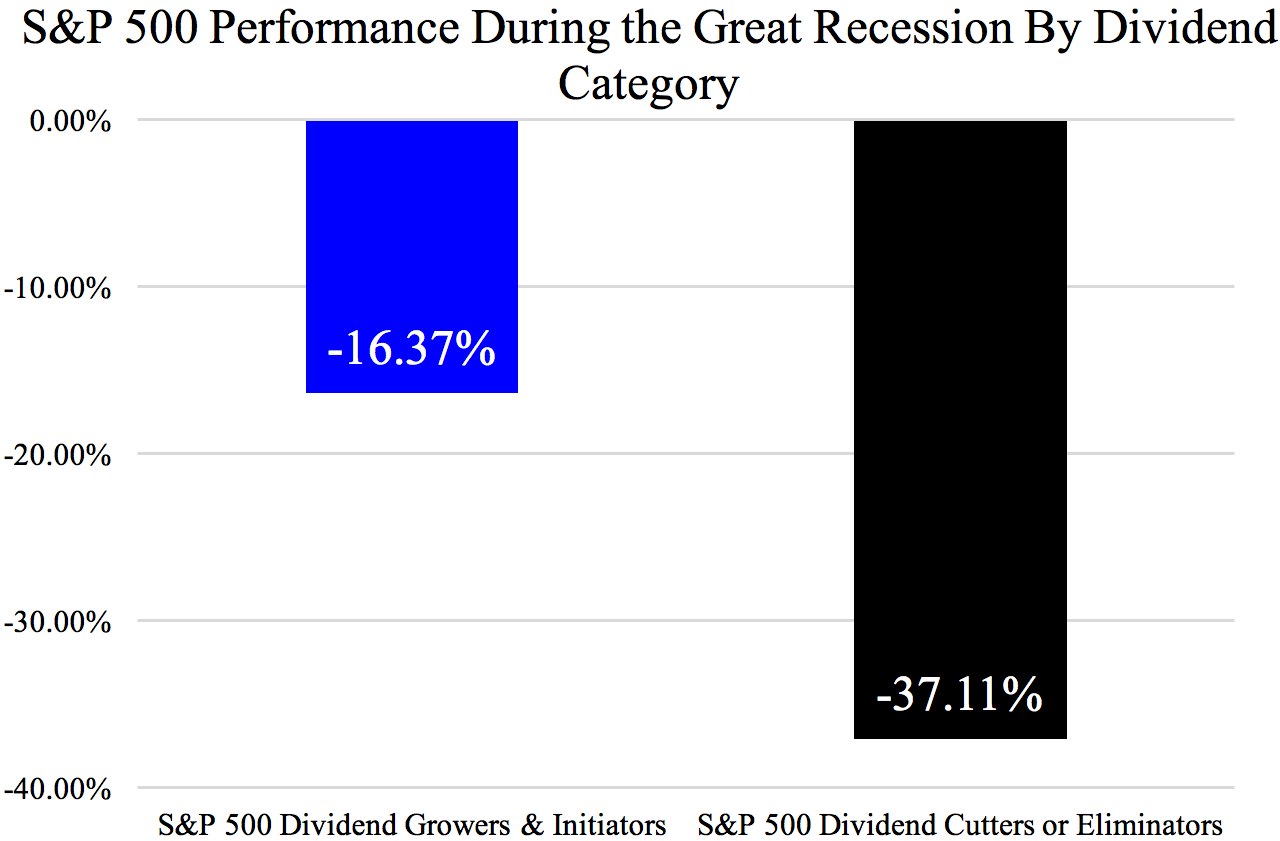Is Your Dividend Growth Strategy Stuck in the Past?
Focusing on companies with strong dividend histories makes sense for investors, but that's only part of the equation. Size matters when you're talking about dividend growth.


The potential power of stock dividends can go a long way for investors. For some, dividend payouts generate income, and for others, dividends are an indicator of a stock’s quality. If a company maintains a long track record of paying dividends, investors may see more stability in growth. Likewise, if a stock makes headlines by cutting or suspending its dividend, investors may panic and could be in for a volatile ride — just look at what happened to GE and Mattel recently.
Certain asset managers use dividend history in an attempt to create a shortlist of potentially high-quality stocks. A number of dividend indexes exist, which filter the large-cap universe down to a group of stocks with 10 to 25 years of consecutive dividend increases. But is this methodology truly effective? Or are these older methods of measuring dividend stock health stuck in the past?
At Reality Shares, our in-depth research into dividend growth investing led to the creation of our very own dividend growth health and rating methodology, allowing us to determine whether these shortlists of dividend-paying stocks are effective in measuring stock quality and resiliency.
From just $107.88 $24.99 for Kiplinger Personal Finance
Become a smarter, better informed investor. Subscribe from just $107.88 $24.99, plus get up to 4 Special Issues

Sign up for Kiplinger’s Free Newsletters
Profit and prosper with the best of expert advice on investing, taxes, retirement, personal finance and more - straight to your e-mail.
Profit and prosper with the best of expert advice - straight to your e-mail.
Rearview Investing Can Be Dangerous
Stocks with a decades-long track record of consistent dividend payouts are impressive. It’s great to see a blue-chip stock living up to its reputation of reliable dividends. But, as a former financial advisor myself, I’m constantly reminded of the proverb, “past performance does not guarantee future results.”
This also applies to dividend investing. A long dividend history is just one dividend payment away from a broken track record. Stock markets are described as leading indicators of a stock’s health, where current market prices reflect investors’ expectations for the future of the market. Solely using past dividend activity is backward-looking, and it doesn't provide much insight into future performance. Investors are unprotected when they are only observing past performance.
Size Does Matter
Time-honored dividend stock lists also miss the magnitude of potential dividend growth. If a stock raised its dividend one penny for each of the last 10 years in a row, does it indicate an improving ability to maximize investor returns? We think the actual magnitude of dividend growth is critically important, as it potentially echoes an improvement in the fundamentals driven by earnings growth or greater cash flow.
We saw this during the second quarter. After successful bank stress tests in June, Citibank doubled its dividend and Bank of America increased its dividend by 60%, reflecting increased stability and positive remarks from the Federal Reserve. Our research shows that a history of strong dividend increases can be a better measure of future total return potential rather than simply incremental ones.
My company’s research shows that many dividend track record-focused indexes are actually weighted by each stock’s corresponding dividend yield. In many cases, the higher the yield, the bigger the stock’s weighting. But, dividend yield can be a function of a recent stock decline, and it may not give a strong indication of a company’s quality. After looking at Bloomberg data between 1992 and 2016, we see that companies with the highest dividend yields actually underperformed the broad equity market on a total return basis.

Source: Bloomberg, Reality Shares Research. Past performance does not guarantee future results. Dividend growth quintiles are based on 5-year dividend growth for the universe of dividend payers among the top 2,000 stocks by market capitalization. The full 25-year time period is broken up into five non-overlapping 5-year segments ending 12/31/1996, 12/31/2001, 12/31/2006, 12/31/2011, and 12/31/2016, then aggregated. Data was normalized across time frames by subtracting relevant 5-year dividend growth and 5-year total return rates of the S&P 500 index. Quintile 1 includes dividend cutters and stocks with no dividend change. Over the full period, there were 640 instances in the first quintile. Of these 295 (46%) were cutters and 116 (18%) were non-growers. 3,166 instances of non-payers.
We don’t find dividend yield to be very useful when building your total return portfolio, as it does not reflect the state of a stock’s balance sheet or income statement.
The Test of Volatile Times
October marked the 10-year anniversary of the market top just before the Great Recession. After this peak, many well-known stocks fell prey to market weakness and cut dividends. Some of the companies even went bankrupt. In this case, investors who looked at dividend yield or how many consecutive dividend payouts a stock made likely didn’t spot signs of trouble. Hallmark stocks lost value, unpleasantly surprising loyal shareholders. Investors learned the hard way that a multi-year track record of incremental dividend increases does not indicate a stock is resistant to declines. That requires a more rigorous approach to dividend growth investing.
In different market environments, stocks that can maintain their dividend growth rates have the potential to outperform stocks with stagnant dividend growth, or dividend cuts. Dividend growers often possess solid fundamentals and have the potential to generate strong returns during bull markets, and they may show more resilience during market declines, as the chart below illustrates.

Data from 1/31/72 – 10/31/17. Source: Ned Davis Research Inc. Dividend policy constituents are calculated on a rolling 12-month basis and rebalanced monthly. Category returns are calculated on a monthly basis. Shown for illustrative purposes only. Past performance is not indicative of future returns. Dividend Growers & Initiators category represents historical performance for companies that either increased or initiated their dividend distribution. Dividend Cutters & Eliminators category represents historical performance for companies that either cut or eliminated their dividend distribution. Equal Weighted category represents historical performance for the 500 largest U.S. stocks by market cap, calculated by assigning the same weighting (0.20%) to each constituent. Non-Dividend Payers category represents historical performance for companies that do not pay a dividend. Bull markets are defined as S&P 500 Index 12-month rolling periods with performance greater than 12%; bear markets as S&P 500 Index 12-month rolling periods with performance less than -6%.
Seek Dividend Growth Leaders
Since dividends are derived from a stock’s underlying earnings, investors can use dividend activity to better forecast a stock’s future prospects. Company dividends are a function of many important factors, including free cash flow, buybacks and earnings forecasts. A dividend growth investing strategy that can potentially maximize investor returns should take these factors into account.
Investing in stocks with the highest rates of dividend growth — what we call dividend growth leaders — puts investors in a stronger position to potentially outperform the market.
Reality Shares developed an analytical tool called DIVCON to evaluate dividend health. It ranks a company’s ability to increase or decrease its future dividends by evaluating seven factors. The methodology seeks to deliver a more accurate picture of a company’s financial health and better predict the probability of an increase or decrease in a company’s dividend over the next 12 months. These factors help DIVCON identify future prospects rather than past dividend changes.
Our research has found that stocks with the highest rates of dividend growth have historically outperformed the market. Our emphasis on dividend growth investing involves vigorously analyzing the drivers of stock price growth and company health.
A small change in approach can make a big difference in your dividend growth investing. Instead of only looking at how long a stock has been paying dividends, seek dividend growth leaders for a potentially better strategy in many market environments.
Learn more about how we rank and analyze dividend-paying stocks using advanced analytics and find important disclosures at Realityshares.com.
Profit and prosper with the best of Kiplinger's advice on investing, taxes, retirement, personal finance and much more. Delivered daily. Enter your email in the box and click Sign Me Up.

Eric Ervin founded Reality Shares, a firm known for ETF industry innovation. He led the launch of investment analytics tools, including Blockchain Score™, a blockchain company evaluation system; DIVCON®, a dividend health analysis system; and the Guard Indicator, a directional market indicator. These tools were designed to help investors access innovative investment strategies as well as provide alternative dividend investment solutions to manage risk.
-
 7 Creative Ways to Spend Less and Save More In Retirement
7 Creative Ways to Spend Less and Save More In RetirementWorried you won't have enough money later in life? Try redesigning your vision of retirement, and you may find your savings go further than you thought.
-
 How to Cover the Income Gap While Your Social Security Grows
How to Cover the Income Gap While Your Social Security GrowsTaking Social Security later results in higher future income, but that can create an income gap. Annuities can boost income until you file for benefits.
-
 Stocks Extend Losing Streak After Fed Minutes: Stock Market Today
Stocks Extend Losing Streak After Fed Minutes: Stock Market TodayThe Santa Claus Rally is officially at risk after the S&P 500's third straight loss.
-
 7 Creative Ways to Spend Less and Save More In Retirement, Courtesy of a Financial Pro
7 Creative Ways to Spend Less and Save More In Retirement, Courtesy of a Financial ProWorried you won't have enough money later in life? Try redesigning your vision of retirement, and you may find your savings go further than you thought.
-
 I'm an Annuities Pro: This Is How You Can Cover the Income Gap While Your Social Security Benefits Grow
I'm an Annuities Pro: This Is How You Can Cover the Income Gap While Your Social Security Benefits GrowTaking Social Security later results in higher future income, but that can create an income gap. Annuities can boost income until you file for benefits.
-
 I'm a Financial Pro: You Really Can Make New Year's Money Resolutions That Stick (and Just Smile as Quitter's Day Goes By)
I'm a Financial Pro: You Really Can Make New Year's Money Resolutions That Stick (and Just Smile as Quitter's Day Goes By)The secret to keeping your New Year's financial resolutions? Just make your savings and retirement contributions 100% automatic.
-
 As We Age, Embracing Our Own Self-Doubt Can Be a Gift: A Cautionary Tale About Elder Financial Abuse
As We Age, Embracing Our Own Self-Doubt Can Be a Gift: A Cautionary Tale About Elder Financial AbuseAn aging couple hired a company that illegally required large deposits, and then they decided to stick with the company even after an employee stole from them.
-
 Domestic vs Offshore Asset Protection Trusts: A Basic Guide From an Attorney
Domestic vs Offshore Asset Protection Trusts: A Basic Guide From an AttorneyLearn the difference between domestic asset protection trusts and foreign or offshore asset protection trusts to help you decide what might work best for you.
-
 Now That You've Built Your Estate Planning Playbook, It's Time to Put It to Work
Now That You've Built Your Estate Planning Playbook, It's Time to Put It to WorkYou need to share details with your family (including passwords and document locations) and stay focused on keeping your plan up to date.
-
 I'm a Wealth Adviser: These 10 Strategies Can Help Women Prepare for Their Impending Financial Power
I'm a Wealth Adviser: These 10 Strategies Can Help Women Prepare for Their Impending Financial PowerAs women gain wealth and influence, being proactive about financial planning is essential to address longevity and close gaps in confidence and caregiving.
-
 I'm a Financial Planning Pro: This Is How You Can Stop These 5 Risks From Wrecking Your Retirement
I'm a Financial Planning Pro: This Is How You Can Stop These 5 Risks From Wrecking Your RetirementYour retirement could be jeopardized if you ignore the risks you'll face later in life. From inflation to market volatility, here's what to prepare for.